Onset of laying in quails
The quail must reach the beginning of laying with the body formed and weighing more than 160 grams. For this to happen, special care is necessary from the beginning of rearing.
Content available at: Onset of laying in quails
The quail must reach the beginning of laying with the body formed and weighing more than 160 grams. For this to happen, special care is necessary from the beginning of rearing.
Español (Spanish) Português (Portuguese (Brazil))
Quails have difficulty making replenishing calcium in the bones during their production period, which further demonstrates the need to await the complete formation of the body to achieve better results as well as showing how important nutrition is during breeding.
The start of aging requires care and has a complicated management due to the need for higher temperatures, between 34ºC and 36ºC. Inattention in this phase can result in noticeable losses in quail development, impairing weight gain, body formation, and uniformity.
The productive life of the Japanese quail is influenced by management, nutrition and photoperiod during rearing, determining the viability and productive longevity of the bird.
One of the most common problems in this phase is excess heat, which causes dehydration, apathy, reduced feed consumption, and crowding, which can lead to high mortality rates. Another problem is the cold. When these birds feel cold, they tend to pile up looking for warmth and in such scenarios, some quails are prevented from going out to feed and drink water, which causes reduced uniformity and can also lead to high mortality rates.
After the critical period between 3 to 5 days of life, it is necessary to gradually reduce the temperature, preparing the quail to be completely without a the heat source, which should occur between 10 and 15 days of life. In the colder times of the year it may be necessary to supply heat at night, up to the 15th day of life, even when quails are already being feathered.
Luminosity is another factor that must be controlled. In the first days, 24 hours of light are provided daily. After 15 days of age, the light supplied is gradually reduced, with the aim of delaying the sexual maturity of the quail, until reaching 13 hours of light per day on the 21st day. It remains so until the start of egg production.
For rearing carried out on floor systems –with masonry structures– it is recommended that: Dusk be natural. The lights should be turned on before dawn, because quail tend to crowd while searching for the first beams of light that enter through cracks (doors, windows, tiles). This reaction can generate high mortalities.
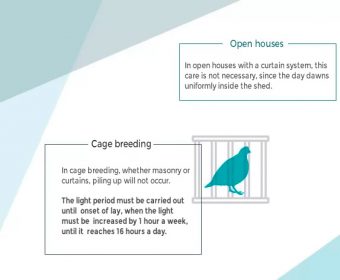
Another important point is the date and quality of the beak treatment. It is a delicate and expensive procedure, but it is very efficient in reducing prolapse problems, uneven uniformity and reaching production peak. The first beak treatment (at 10 days of age) may be smoother than the second and more severe one near the 30 days mark. The first beak treatment allows for an improvement in body weight gain, while the second one allows for a more homogeneous consumption of the ration (it guarantees the consumption of a balanced diet), lowering defecation rates in the birds and consequently reducing feed waste, and avoiding cloaca pecking. 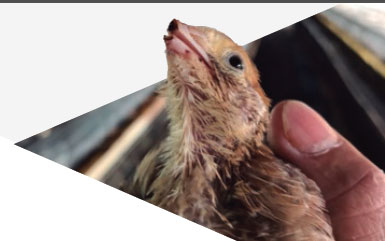
Density during rearing
Another important factor that can influence the formation of the quail’s body is the density used in breeding. When higher than recommended levels, quails development is impaired and flock uniformity is compromised. In addition to respecting the area in cm² recommended by the genetic line, it is important to note the number of feeders as well as the number of nipple drinkers available per housed quail. The feeders must offer a minimum of 1.4 cm of space per quail and at least 1 nipple must be provided for every 20 quails
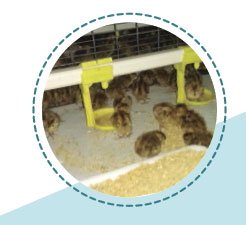
With the control of the luminosity, adequate management in the rearing and quality nutrition, the birds will develop properly and can be transferred to the laying house at 37 – 40 days of age, before the start of the lay which will occur around the 42 to 45 day mark. The date of the transfer requires a margin of safety that prevents the transport of quail already in lay, preventing an internal laying from occurring, broken eggs in the oviduct, in addition to lesions in the ovary that can impair the start of production and even reduce viability.
The transfer requires a lot of care, the handling of the birds must be done in a gentle way to avoid injuries:
In the laying house, it is necessary to verify the pressure and flow of the drinkers, as well as access to the feed in the troughs, as in some situations quail may have difficulty in drinking or eating. This must be observed and corrected quickly . It is very important that the sheds have only one age of birds and that an all-in all-out system is used . There is no good cleaning and disinfection if there are other birds from another flock in the house. Proper cleaning and disinfection breaks the cycle of pathogenic bacteria and viruses present in the house and decreases future challenges for the quails, making the task of adapting to the new environment easier.
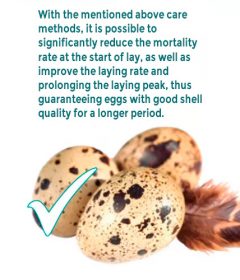
Conclusions
A flock of quail that starts laying with birds below their proper weight, without completing the development of the body and/or with low uniformity, will have a higher mortality at the start of production and will have a shorter productive life, when compared to birds that have met those requirements.
The main cause of mortality at the beginning of the production cycle is related to prolapse and the cause of this is directly related to the body weight of the quail and its body development.
Another important factor in the issue of prolapse is the beak treatment, making sure that quails do not peck each others’ cloacas when under bright light.
In brighter luminosity, or with natural light, pecking occurs because after laying, the reddish coloration of the cloaca and its movement of contractions to return to the original form, makes other quails curious, enticing them to start pecking. This leads to the formation of edema and hinders the cloaca to return to its natural form, which eventually causes prolapse by the time of laying the next egg.
The increasing growth rate of the quail market in recent years and the demand for eggs, have led quail farmers to invest in farms with expensive and modern structures. And, to honor the financial commitments made, in addition to the difficulty of finding qualified labor, farmers and technicians cut corners on some management practices that are extremely important to achieve high production levels. As the facilities were new and the investments did not stop from happening, this masked the problems that were to come.
However, the sector must rethink its way to approach farm management, prioritizing sanitary management and the welfare of the birds, which must have their needs met so that they can express their full genetic potential. 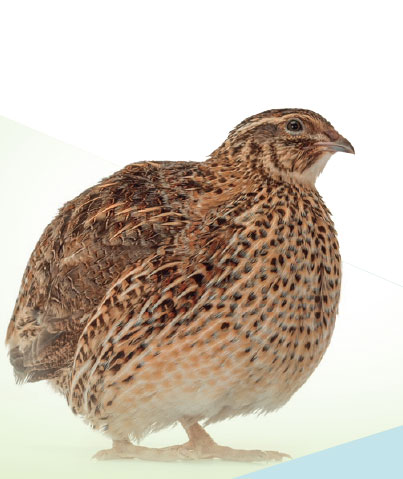
Subscribe now to the poultry technical magazine
AUTHORS

Layer Longevity Starts at Rearing
H&N Technical Team
The Strategy for a Proper Infectious Bronchitis Control
Ceva Technical Team
Elevate Hatchery Performance with Petersime’s New Data-Driven Incubation Support Service
Petersime Technical Team
Maize and Soybean Meal Demand and Supply Situation in Indian Poultry Industry
Ricky Thaper
Production of Formed Injected Smoked Chicken Ham
Leonardo Ortiz Escoto
Antimicrobial Resistance in the Poultry Food Chain and Novel Strategies of Bacterial Control
Edgar O. Oviedo-Rondón
GREG TYLER INTERVIEW
Greg Tyler
Insights from the Inaugural US-RSPE Framework Report
Elena Myhre
Newcastle Disease: Knowing the Virus Better to Make the Best Control Decisions. Part II
Eliana Icochea D’Arrigo
Avian Pathogenic E. coli (APEC): Serotypes and Virulence
Cecilia Rosario Cortés
The Importance of Staff Training on Animal Welfare Issues in Poultry Industry
M. Verónica Jiménez Grez
Rodent Control is a Key Factor in Poultry Biosecurity and Sustainability
Edgar O. Oviedo-Rondón